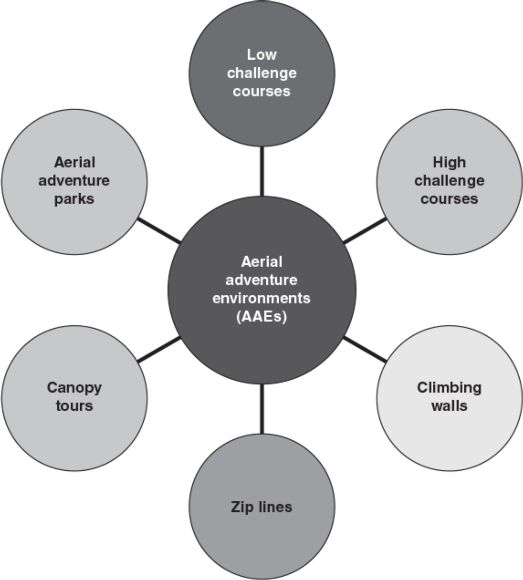What is an aerial adventure environment?
This is an excerpt from Aerial Adventure Environments With HKPropel Access by Elizabeth A. Speelman,Mark Wagstaff,Scott H. Jordan & Kathy Haras.
Haras (2012) unpacks the term aerial adventure environment by defining each word. Aerial refers to the fact that the experience occurs above the ground, whether by only a few inches or at great height, and therefore requires specialized skills and equipment. The experience also involves adventure (individual or in a group) and is chosen because it poses a challenge and entails at least a perception of uncertainty. Finally, the word environment refers to both the physical structures and the delivery method of the experience. Using this broad idea of AAEs, we can now explore what this type of experience encompasses.
In order to do so, we need to define another term—challenge course, which is given two widely known definitions in the industry. Rohnke, Rogers, Wall, & Tait (2007) define a challenge course in terms of the ropes, cables, metal, synthetics, and poles used to build structures that challenge participants in a manner that mimics that of a natural setting. Alternatively, Attarian (2005) views challenge courses in terms of their similarity and relationship to other activities, such as group initiatives, team-building activities, and low and high ropes courses. Although both of these definitions address the physical structure of at least some of the activities, they differ in the scope of what they might include. The definition from Rohnke et al. includes the materials that the challenge course can be made from and implies that they are relatively permanent in design. However, as the industry grows and changes, so do the technologies and materials used in assembling challenge courses. In contrast, Attarian's (2005) inclusion of terms such as group initiative and team-building activities enables a broader interpretation of the activities that can be used in challenge course programming.
This broader definition is used in most educational settings. For instance, even if a program takes place predominantly on a low or high challenge course, facilitators typically initiate the course by incorporating some activities that require little or no equipment. But what if these team-building activities are used without inclusion of more permanent structures? Does the overall activity still constitute a challenge course program? Thus begins again the debate about what is and what is not included in an AAE.
When talking about what is included in an AAE, it is helpful to understand the difference between an environment and an element. The environment consists of the overall structure and structural style, which carry implications for the type of delivery system one can use. Elements, on the other hand, are the individual components of an AAE that are used to enable specific experiences. An incredible number of elements already exist for AAEs, and more are being designed even as you read this book. Indeed, it would be impossible to list, much less explain, all of the elements that have been installed in AAEs, and any such list would very quickly fall out of date; therefore, no such list is included here. Instead, we address selected elements as they relate to various operating systems or experiences.
It is crucial to understand the varying environments in order to grasp all that is included in our definition of an AAE. The aerial adventure industry has grown beyond the previously stated definitions of a challenge course, and we now determine what to include in the definition of AAEs by considering programmatic uses, structural designs, operating systems, and even standards and regulations. Figure 1.1 shows how AAEs can be divided into six major categories. Each of these categories has some unique features and programmatic uses that will be highlighted throughout this textbook. The term aerial adventure environment,or AAE, is used when the reference is common to all of these categories.

Figure 1.1 Aerial adventure environments.
Used with permission of Adventureworks! Associates, Inc.
More Excerpts From Aerial Adventure Environments With HKPropel AccessSHOP

Get the latest insights with regular newsletters, plus periodic product information and special insider offers.
JOIN NOW


